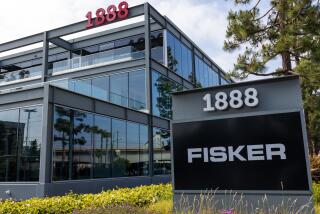Chrysler tries to steer out of its difficulties
Chrysler is trying to cut its way back to significance. It’s going to hurt.
The automaker’s 71,000 employees will be on “mandatory vacation” for two weeks in July when all operations across the country are shut down, the company said Thursday.
A forced break is drastic, though for Chrysler perhaps not surprising considering its financial straits.
After losing $1.6 billion last year, it announced plans to shutter offices, reduce its workforce, eliminate dealerships and do away with redundant models. But with one of the least fuel-efficient fleets on the road, inventory piling up on dealer lots and the popularity of its top seller -- the Dodge Ram pickup -- slumping along with the housing market, there’s reason to suspect that cutting alone won’t be the solution.
Unless Chrysler figures out how to increase sales and build cars and trucks that people want, the 83-year-old company’s prospects will be dim.
“Chrysler is in a tailspin,” said Dennis Virag, president of the Automotive Consulting Group in Ann Arbor, Mich., repeating oft-heard speculation that the carmaker may be forced to sell off valuable assets. “In two or three years, there may not be a stand-alone Chrysler company anymore.”
The comedown has been dramatic for Chrysler, which is No. 4 in U.S. sales volume behind General Motors Corp., Toyota Motor Corp. and Ford Motor Co. (Toyota has plans to cut back too, saying Thursday that it would trim production of full-size Tundra pickup trucks as U.S. vehicle sales slow.)
After nine years under the direction of German automaker Daimler, Auburn Hills, Mich.-based Chrysler was acquired in August by Cerberus Capital Management in a highly leveraged, $7.5-billion deal. Hopes were raised that a private equity firm, thanks to its relative agility compared with publicly held companies, would be able to rapidly turn Chrysler’s fortunes around.
To do that, Cerberus hired Robert Nardelli, former head of Home Depot Inc., as chief executive and brought on Toyota’s top man in the U.S., Jim Press, as vice chairman and president, a brain trust that had the industry buzzing.
But slumping credit markets, combined with Chrysler’s continuing problems of overproduction, excess inventory and a dealer network far too large for its market share, turned the renewal efforts into what Nardelli called “recovery” in Thursday’s memo to employees.
“We ask that you approach this idea with an open mind and a team spirit,” the memo said. “It’s going to take your cooperation and teamwork to achieve success.”
Last month at the annual trade show for dealers, Press announced plans to reduce the number of dealers by combining the company’s Chrysler, Dodge and Jeep brands on single lots, encouraging larger dealers to buy out smaller ones in the process.
Press also said the company would eliminate redundancies in vehicle lineups, singling out two minivans, the Dodge Caravan and Chrysler Town & Country, that essentially compete with each other.
The news was generally well-received by dealers, who have faced slipping profitability as Chrysler vehicles pile up on their lots despite aggressive attempts to move them.
This month Chrysler increased incentives by 5%, to an average of $3,579 per vehicle, and it is offering as many as seven years with no interest on financing some models. In February Chrysler sales declined by 14% compared with the previous year, and in January they fell by 12.1%, according to Autodata Corp.
“There’s no secret. They’re struggling,” said Tom Libby, an analyst with J.D. Power & Associates. “They need to improve their performance in traditionally important categories.”
Chrysler’s fleet of about 30 vehicles is long on trucks and sport utility vehicles, but lacks many of the vehicles that have been seeing sales gains of late, including highly efficient smaller cars. Rivals Ford, GM, Toyota and Honda Motor Co. have been selling hybrid vehicles in the U.S. for years; Chrysler will introduce its first hybrids, the Dodge Durango and Chrysler Aspen, which sport 5.7-liter V8 engines, this fall.
With gasoline averaging $3.23 a gallon nationwide as of this week, and stricter federal emissions standards now on the books, observers said there was considerable financial peril at hand for Chrysler unless it made more fuel-efficient vehicles.
Equally troubling is the lack of a blockbuster product to draw buyers to lots. Several years ago Chrysler had a certifiable hit in its 300 sedan, but it has not been able to repeat that success even as competitors such as GM rolled out winners including the Chevrolet Malibu.
In the crucial family sedan class, the company still offers the 300 -- now a “bit long in the tooth,” according to analyst Virag -- the Sebring, which has been repeatedly panned by critics, and the Avenger, which Chrysler plans to scrap.
And while Ford and GM increasingly turn to robust international sales to make up for weaknesses in the domestic market, Chrysler has almost no foreign exposure. Last year, it sold about 200,000 cars overseas, compared with nearly 2.1 million in the U.S.
Faced with such challenges, Chrysler has moved to reduce its workforce by offering buyouts and early retirement packages aimed to eliminate 10,000 factory jobs. It has also taken steps recently to lay off upward of 1,000 salaried workers, including engineers.
Increasingly, rumors have been swirling about whether Chrysler will be forced to sell off valuable assets if its fortunes don’t turn around. A leading candidate would be Jeep, which is widely considered to have the most value among Chrysler brands.
Last month at the auto dealers convention, Press reacted forcefully to questions about the company’s viability, calling suggestions that Chrysler couldn’t survive “hogwash.”
Critics have little trouble finding evidence that might suggest otherwise. Last week Chrysler said it would shutter its influential Pacifica Design Studio in Carlsbad, although almost all other automakers maintain studios in Southern California.
“At the end of the day, if you’re not out here and your competitors are, it could hurt you,” said John Grafman, executive director of the Auto Design Organization. “Is it short-term thinking? Quite possibly.”
--






